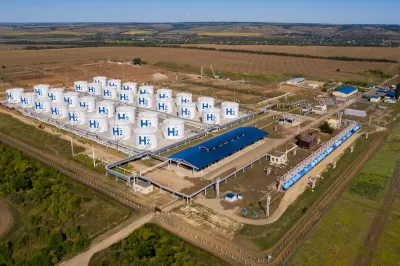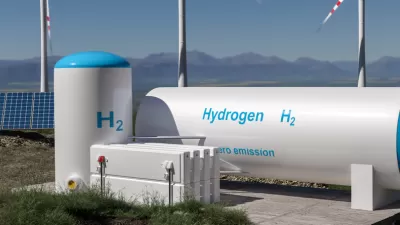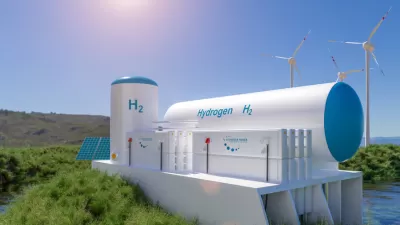The U.S. Department of Energy announced on July 17 that the first grant to build the nation's seven proposed 'hydrogen hubs' would go to California. The ultimate goal is to decarbonize transportation fuels used in port operations.

The Energy Department's Office of Clean Energy Demonstrations announced on July 17 the award of $30 million to the California Hydrogen Hub, “a network of clean hydrogen production sites that incorporate multiple facilities at California ports.”
The expansion of hydrogen fuel cell vehicles in heavy-duty transportation aims to not only drive improvements in air quality along high pollution interstate transportation corridors but also to facilitate greater connectivity and expansion of a clean West Coast freight network that links to the Pacific Northwest Hydrogen Hub.
“California’s hub will produce hydrogen exclusively from renewable energy [known as green hydrogen] and biomass, while other hubs will experiment with other sources,” reported Hayley Smith for the Los Angeles Times on Oct. 13, 2023, when the U.S. Department of Energy announced “$7 billion to launch seven Regional Clean Hydrogen Hubs (H2Hubs) across the nation” made possible by the passage of the Infrastructure Investment and Jobs Act (IIJA) on Nov. 5, 2021.
Pacific Northwest H2 Hub
A week after the Office of Clean Energy Demonstrations awarded the initial funds to kickstart the California hub, OCED awarded $27.5 million to the Pacific Northwest Hydrogen Hub.
OCED is working with PNWH2 to build a clean hydrogen ecosystem across Washington, Oregon, and Montana that leverages the region’s abundant renewable resources to produce all of its hydrogen exclusively via electrolysis using clean, carbon free energy, facilitating greater connectivity and expansion of a clean West Coast freight network that links to the California Hydrogen Hub.
Clean hydrogen
The Rhodium Group shed light on the distinction between clean and conventional hydrogen in a nine-page report published Sept. 9, 2021, a month after the IIJA passed the Senate and nearly two months prior to passage in the House.
As Congress considers policy support for hydrogen technologies, it is essential to understand the distinction between how we use hydrogen today and the role of hydrogen in a decarbonized US economy. Hydrogen currently plays a crucial function in our economy, primarily as an industrial feedstock. Nearly all of today’s supply is from steam methane reformation, an emissions-intensive form of hydrogen production made from natural gas.
Russ Mitchell, who covers energy technology, including the state’s ambitious transition to electric vehicles, for the Los Angeles Times, reported on July 17 that “some environmentalists are wary of hydrogen, claiming it’s not as clean as its proponents make it out to be.”
That issue is sure to be debated as [the Alliance for Renewable Clean Hydrogen Energy Systems ] ARCHES moves forward. Depending on how the hydrogen is made, it could provide cleaner energy alternatives for hard-to-decarbonize sectors, such as steelmaking and cement production.
Additional reading:

Alabama: Trump Terminates Settlements for Black Communities Harmed By Raw Sewage
Trump deemed the landmark civil rights agreement “illegal DEI and environmental justice policy.”

Planetizen Federal Action Tracker
A weekly monitor of how Trump’s orders and actions are impacting planners and planning in America.

The 120 Year Old Tiny Home Villages That Sheltered San Francisco’s Earthquake Refugees
More than a century ago, San Francisco mobilized to house thousands of residents displaced by the 1906 earthquake. Could their strategy offer a model for the present?

Seattle Voters Approve Social Housing Referendum
Voters approved a corporate tax to fund the city’s housing authority despite an opposition campaign funded by Amazon and Microsoft.

The Five Most-Changed American Cities
A ranking of population change, home values, and jobs highlights the nation’s most dynamic and most stagnant regions.

USDOT Repeals Emissions Monitoring Rule
A Biden-era regulation required states to report and plan to reduce transportation-related emissions.
Urban Design for Planners 1: Software Tools
This six-course series explores essential urban design concepts using open source software and equips planners with the tools they need to participate fully in the urban design process.
Planning for Universal Design
Learn the tools for implementing Universal Design in planning regulations.
Ada County Highway District
Clanton & Associates, Inc.
Jessamine County Fiscal Court
Institute for Housing and Urban Development Studies (IHS)
City of Grandview
Harvard GSD Executive Education
Toledo-Lucas County Plan Commissions
Salt Lake City
NYU Wagner Graduate School of Public Service





























